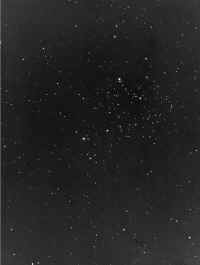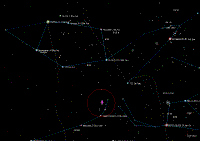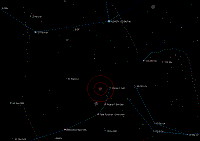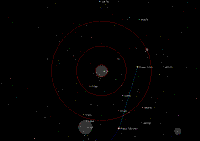M35 (open cluster in Gemini)
520: M35 image
M35 is a beautiful open cluster in Gemini. It was discovered by de Cheseaux in 1745 or 1746, independently rediscovered by John Bevis before 1750, and finally logged by Messier on August 30, 1764. M35 comprises more than 200 stars, of which 120 are brighter than magnitude 13, scattered over an area of about 30 arcminutes, or about the extent of the full moon. M35 is about 110 million years old, which makes it a young to middle-aged open cluster. At magnitude 5.3, M35 is a naked-eye object under dark, clear conditions, although I’ve never spotted it naked eye at Bullington.
530: M35 with binocular
The Astronomical League rates M35 as an “Easy” object with 7X50 binoculars, as indeed it is from Bullington. To locate M35 in binoculars, orient yourself from Auriga and Betelgeuse in Orion to locate the three foot stars in Gemini. The brightest of those at magnitude 2.88 is Tejat Posterior, also called Pish Pai. With Pish Pai in centered in your field, swing your binocular toward Alnath until Pish Pai is near the edge of the field. M35 will be visible as a bright cluster about full-moon sized.
540: M35 with Telrad (overview)
It’s not much harder to get M35 into your eyepiece. Once you’ve oriented yourself to the foot stars in Gemini using your binocular, orient your Telrad as shown relative to Pish Pai and Propus 7 Eta Gemini, which are both 3rd-magnitude, and 4th-magnitude Propus 1 Gemini.
550: M35 with Telrad (detail)
Here’s the same view in more detail. With the Telrad oriented as shown, M35 should be visible in a low-power eyepiece. If not, it will be visible in your optical finder, which you can use to center the view. We generally start with our 30mm Ultrascopic, which has a 1.3 degree field of view in our scope. That lets us view M35 in context with the surrounding stars. To zoom in, we use our 14mm Pentax XL, whose ¾ degree field of view frames M35 nicely and allows us to view detail within the cluster.



